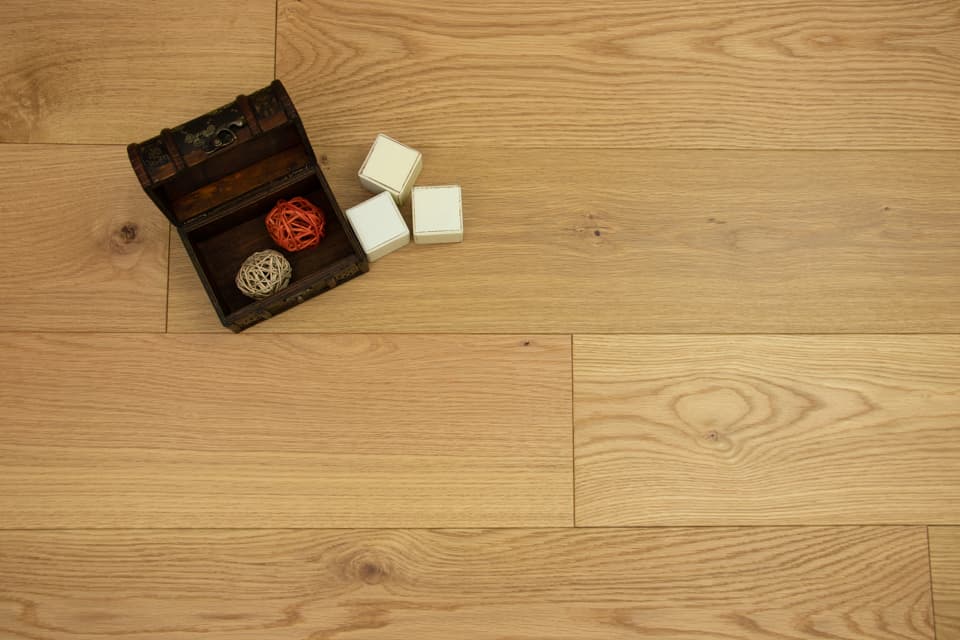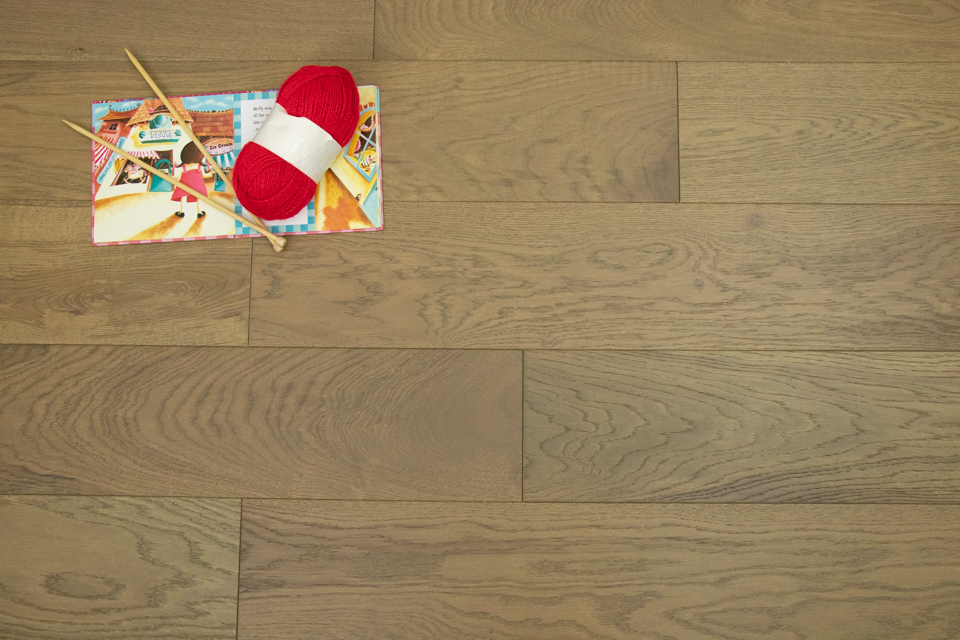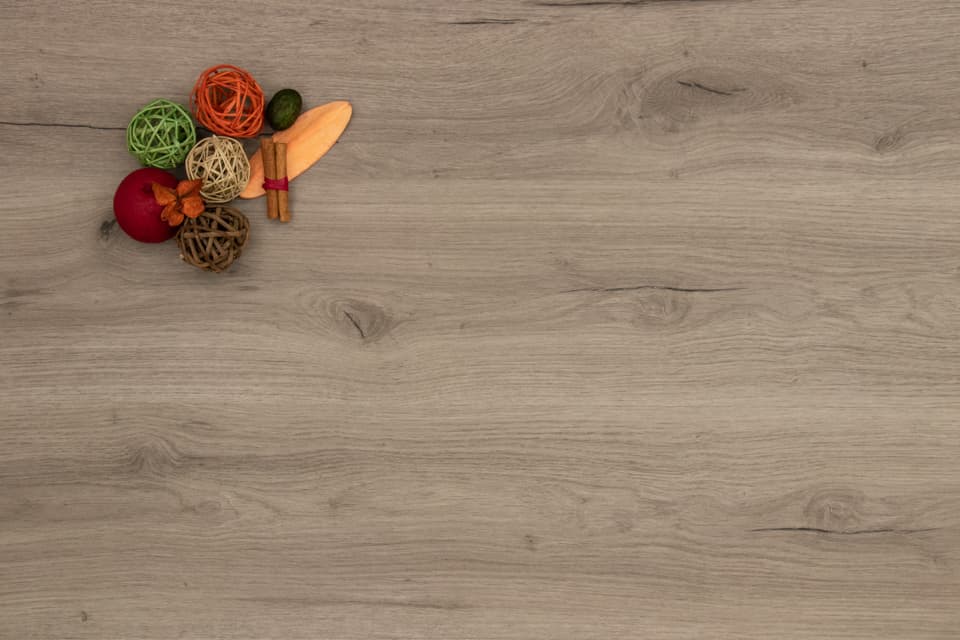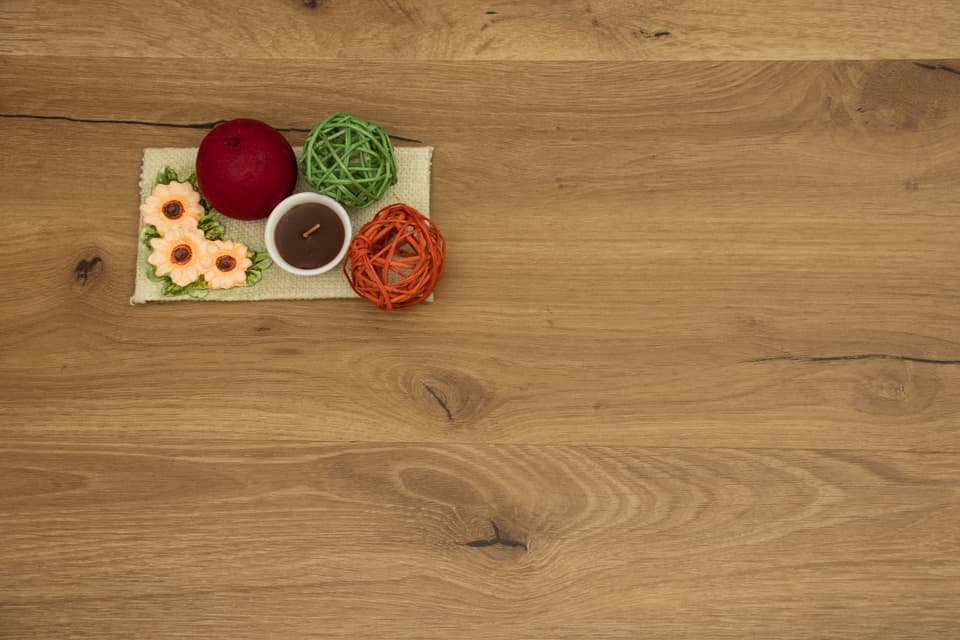Oak flooring is a diverse realm, offering a myriad of options for customers. Gone are the days when oak flooring was confined solely to the solid wood variant. If in past decades your oak flooring choices were limited, today, the spectrum has widened to include engineered oak, laminate oak, and luxury oak effect vinyl, thereby catering to budget-friendly and more upscale tastes alike. Prices are influenced by numerous factors, including the type of flooring and its characteristics like dimension, finish, style, and grade. This guide provides insights into both affordable and high-end oak flooring solutions.
Solid Oak Flooring

Solid oak flooring manufactured using 100% oak wood
Historically, solid oak flooring has been the traditional choice. Its planks are manufactured using 100% oak wood with thicknesses ranging from 16mm to 20mm. Each board’s price is influenced by four common grading scales, from the premium-priced prime grade to the more economical, rustic grade. This grade reflects aesthetic variations, such as colour, sap, and knot density on the board. It’s vital to remember that grade doesn’t equate to quality – it is purely a visual measure. Solid oak flooring is also categorised by style. Plank-style is relatively affordable, while herringbone and chevron styles carry a higher price tag. Consequently, cheap solid oak flooring usually consists of 16mm thick, rustic grade planks, while more expensive options are 20mm thick, prime grade boards designed in herringbone or chevron styles.
Engineered Oak Flooring

Engineered oak floorboards incorporate real oak, but solely for the top layer
Since the early 2000s, the advent of engineered oak flooring has witnessed a shift from traditional solid oak flooring. Engineered oak floorboards incorporate real oak, but solely for the top layer, whereas the core consists of synthetic materials. Utilising less real oak makes engineered oak flooring considerably more cost-effective compared to its solid counterpart while retaining the identical visual appeal of true oak. Unlike solid oak, which is prone to damage under damp, humid, or high-temperature conditions (like in bathrooms or above underfloor heating), engineered oak flooring is adept at handling these conditions. Just like solid oak, grade and style factors impact the price. However, due to its synthetic core, engineered oak flooring is available in thinner dimensions, further reducing its cost. The cheapest engineered oak flooring is usually 10/2mm (8mm core and 2mm oak layer) in a rustic grade, plank style. The more expensive options include 20/6mm boards in prime grade, herringbone or chevron style. Yet, even the priciest engineered oak flooring tends to cost less than its equivalent in solid form.
Laminate Oak Flooring

Laminate oak flooring offers ‘oak look’ alternative
Laminate oak flooring, thanks to its modern Abrasion Criteria (AC) grading system, offers clarity in distinguishing between budget and high-end options. AC is indicative of the floor’s resistance to wear and tear. The higher the AC, the greater the floor’s durability. For instance, AC1 is designed for light use, while AC6 is suitable for commercial settings. In most residential settings, AC3 and AC4 strike the perfect balance between cost and performance. Similar to solid and engineered oak flooring, style significantly influences the price, with plank style being more affordable than herringbone or chevron styles. In laminate oak flooring, instead of thickness, durability is reflected in the AC grade, and board size mainly comes down to width, which ranges from 100mm to 197mm. Hence, cheap laminate oak flooring options generally comprise AC1 grade, plank-style flooring in 100mm width, while more expensive variants boast an AC6 rating, herringbone style, and 197mm width. However, it’s recommended to avoid AC1 and AC2 laminates as they’re meant for light use, whereas AC4 and AC5 are better suited for busy households.
Luxury Oak Effect Vinyl Flooring

Luxury oak effect vinyl flooring is a high-quality synthetic flooring solution ingeniously designed to mimic natural oak’s appearance
Luxury oak effect vinyl flooring is a high-quality synthetic flooring solution ingeniously designed to mimic natural oak’s appearance, achieved through an intricately printed decorative film layer. Recent advancements in this field have introduced the SPC (Stone Plastic Core) variant, which, along with traditional options like Wood Composite Core (WPC) and Polyvinyl Chloride (PVC), forms the core of these boards. SPC, also known as Rigid Core, offers superior durability, making it a popular choice for commercial settings and busy households, and therefore more expensive. Similar to other flooring types, style influences the price, with plank styles being more budget-friendly compared to herringbone or chevron styles. The thickness and width of the luxury oak effect vinyl flooring also play a role in its pricing. The most affordable options usually consist of 4mm thick, 100mm wide boards with a PVC or WPC core. In contrast, the pricier variants feature an SPC core with 8mm thick, 178mm wide boards, and come in herringbone or chevron styles.
Oak Flooring Options: From Cheapest to Expensive
| Solid Oak Flooring | Engineered Oak Flooring | Laminate Oak Flooring | Luxury Oak Effect Vinyl | |
|---|---|---|---|---|
| Composition | 100% Oak wood | Real Oak top layer, synthetic core | Synthetic material, Oak image | Synthetic material, realistic Oak print |
| Price Range | ££ – £££ | ££ – £££ | £ – ££ | £ – £££ |
| Thickness | 16mm – 20mm | 10mm – 20mm | Depends on AC rating | 4mm – 8mm |
| Durability | Moderate (susceptible to damp/humidity) | High (resistant to damp/humidity) | Depends on AC rating | High (especially SPC core) |
| Suitable Environments | All residential, less suitable for bathrooms/underfloor heating | All residential, including bathrooms/underfloor heating | All residential, light to heavy usage depending on AC rating | All residential, commercial, busy households |
| Style Options | Plank, Herringbone, Chevron | Plank, Herringbone, Chevron | Plank, Herringbone, Chevron | Plank, Herringbone, Chevron |
| Cheapest Example | 16mm, Rustic Grade, Plank Style | 10/2mm, Rustic Grade, Plank Style | AC1, Plank Style, 100mm width | 4mm, 100mm width, PVC/WPC core |
| Most Expensive Example | 20mm, Prime Grade, Herringbone/Chevron Style | 20/6mm, Prime Grade, Herringbone/Chevron Style | AC6, Herringbone Style, 197mm width | 8mm, 178mm width, SPC core, Herringbone/Chevron Style |
Legend: £ = Cheap, ££ = Mid-range, £££ = Expensive
In conclusion, when navigating the sea of oak flooring options, your choice will likely come down to a balance between budget, aesthetics, durability, and the specific needs of your space. With its robust construction and visually appealing surface, engineered oak flooring delivers the charm of solid oak without its susceptibility to moisture and temperature changes, all at a more affordable price. It represents an ideal blend of traditional beauty and modern functionality, making it a standout option for those seeking an affordable, yet high-performing flooring solution.
On the other hand, for those seeking superior durability with a versatile aesthetic appeal, luxury oak effect vinyl, specifically the SPC variant, makes a compelling case. Despite being a synthetic product, it masterfully emulates the appearance of natural oak, making it nearly indistinguishable from the real deal. Coupled with its exceptional resilience, it is perfect for areas subjected to heavy foot traffic, including commercial settings and bustling households.
—
FAQ
What factors influence the price of oak flooring?
The price of oak flooring is determined by the type of floor (solid, engineered, laminate, or luxury vinyl), as well as features such as dimension, finish, style, and grade. Within each flooring type, these features can significantly impact the final cost.
How does the grading system affect the cost of solid oak flooring?
The grading system for solid oak flooring ranges from the most expensive prime grade to the cheapest, rustic grade. This grade reflects the visual variations on the board, such as colour, sap, and knots. However, it’s important to note that the grade doesn’t equate to quality, but it is a visual measure.
What makes engineered oak flooring more cost-effective than solid oak flooring?
Engineered oak flooring uses real oak, but only for the top layer. The core consists of synthetic materials, which reduces the overall cost as it uses a lesser amount of real oak. This makes engineered oak flooring more affordable compared to solid oak flooring while still providing the same visual appeal.
How does the Abrasion Criteria (AC) affect the price and durability of laminate oak flooring?
The AC grading system is indicative of the floor’s resistance to wear and tear. For instance, AC1 is designed for light use, while AC6 is suitable for commercial settings. In most residential settings, AC3 and AC4 strike the perfect balance between cost and performance. Therefore, the AC grade can significantly impact the price and durability of laminate oak flooring.
What is the difference between the core types of luxury oak effect vinyl flooring?
The core types of luxury oak effect vinyl flooring can be Wood Composite Core (WPC), Polyvinyl Chloride (PVC), or Stone Plastic Core (SPC). Among these, SPC, also known as Rigid Core, offers superior durability, making it a popular choice for commercial settings and busy households, and therefore, more expensive.








